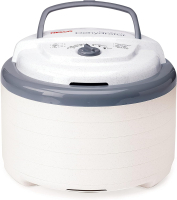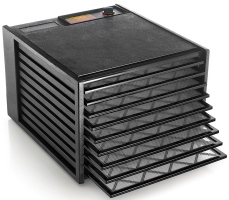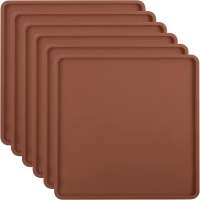Buy Food 
For Equipment 
Breville Smart Oven with
Dehydrating
Wirecutter and CR's Top Pick
4 trays for dehydrating. 86°-176°F

Best Selling Dehydrator:Nesco 5 to 12 Tray Dehydrator

For the Serious User:Excalibur 9 Tray Dehydrator

Silicone Dehydrator Sheets
for Excalibur

Prep
Paleo Jerky Seasonings
Some good spices for jerky include: cumin, ground chipolte, garlic powder, marjoram, chili powder, you can even use a good quality taco or fajita seasoning mix (such as Spice Hunter brand, no MSG). I like to coat only one side of the meat with seasoning otherwise the flavors are too overpowering. I always vary spices when I make jerky; I haven't found an exact formula that I love, in fact I have found that I actually prefer it plain or with just a little cracked pepper.
For the ginger, I'd marinate the meat with slices of ginger before drying. Or you could rub ginger juice into the meat. There are special Japanese grates made of ceramic which are used for grating ginger. Just squeeze the grated ginger to extract the juice. FYI: You can peel fresh ginger safely and effectively using a teaspoon! If your ginger doesn't peel easily with a teaspoon, it's not fresh.
By Stacie Tolen. Posted to the PaleoRecipe Mailing List, March 2001
To Print the Recipe, or to Post and/or Read
Comments
Dehydrator
Hans' Jerky Recipe
My main food is jerky made from ordinary ground meat ("organic" 10 % fat, or game) as I buy it in the shop (sometimes frozen). I mix cautiously with a little olive oil and seasoning (herb) or grated raw carrots. NO SALT. Then I just spread "meatballs" onto the dehydrator wire mesh with the help of a fork. Dry at 30 degrees C (=centigrades). Can be stored (above the fridge) for at least a month without any spoilage. Cheap, easy, practical, tasty!
From: Hans Kylberg
To Print the Recipe, or to Post and/or Read
Comments
Hans' Recipe for Dried Meat
You can certainly dry meat in any dehydrator. In fact it is easier than most veggies/fruits. Just cut thin slices, or do as I do: Buy lean ground meat, mix with herbal spices (such as thyme), and smear with a fork directly on tray mesh, making flakes 1 - 2 inches across and 1/16 - 1/8 inch thick.
From: Hans Kylberg
To Print the Recipe, or to Post and/or Read
Comments

Jerky Recipe
To make jerky, take a raw piece of beef round or chuck, quite lean and slice it thin, across the grain. Lay the slices across the racks of the dryer for two days and nights -- test it by breaking a piece, it is dry enough when it cracks in two when you break it. The smaller and thinner you cut the pieces of meat before drying them, the quicker they will get tender as you soak and cook them (remember, its easier to slice thinly if the steak is partially frozen).
One pound of sliced beef dries to 4 ounces of jerky, making a ratio of undried to dried meat of about 4:1.
Before drying the meat, you can season it with some combination of the following spices: paprika, pepper, salt, or other concoctions. Garlic is wonderful on jerky. I recommend rubbing the meat with cut cloves of garlic before slicing it. A marinade will change the taste slightly, and cause the meat to take longer to dry. Marinating tenderizes the meat however.
From:
The Hungry Hikers Book of Good Cooking by Gretchen McHugh
To Print or Pin the Recipe, or to Post and/or Read
Comments

General Jerky Method
All recipes use 1 lb lean meat, thinly sliced. (3/16-1/4 in thick)
In a small glass bowl, combine all ingredients except meat. Stir to mix well. Place meat 3-4 layers deep in a container, spooning sauce mixture over each layer. Cover tightly and marinate 6-12 hours in the 'fridge, stirring occasionally and keeping the mixture covered.
I can't really help with drying instructions, but I'd say somewhere between 7-10 hours, depending on how you like it.
From: rec.food.preserving
To Print the Recipe, or to Post and/or Read
Comments

Salmon Jerky Recipe
I slice the filets in 1/2 cm thin slices leaving the skin on (most of the oil is underneath the skin so you don't waste it neither oxydise it that way ) put in the drier at body temperature and dry hard for storage and half dried for delicacy to eat on the spot.
No need for anything else that will spoil the taste that is superb on its own especially with coho or sockeye (the best species of salmon).
Dried that way the salmon keep its "instinctive stop" sharp and clear. If your body metabolism don't want salmon you will know it clearly if it want it the taste is sublime.
When you season you can bypass this instinctive response and eat something that will become a burden on your metabolism.
I am under the impression that putting salmon in Brine or lemon juice or whatever which interfere in the osmotic balance between inside and outside of the cells, will use up Enzymes as well as heat, triggering all kinds of chemical reactions altering the originel nutrient content. By adding honey or sugar even more so (proteins and sugars combine).
The oil is highly oxydable, so to store dry salmon keep in air tight jar inside the fridge in darkness.. (it is why it is so important to leave the skin on while drying .
Once dried insert a round ended knife between the skin and the flesh, you can easily separate the two and scrape the skin to get the fat layer. (The best when you need that kind of fat.)
From: jean-claude on the PaleoFood list. Posted 7 Aug 2000.
To Print the Recipe, or to Post and/or Read
Comments

Oven
Basic Beef Jerky Recipe
Use lean beef with as much of the fat trimmed off as possible. (Actually, just about any meat should work -- the original recipe calls for buffalo.)
Cut into strips about 1/8" thich and 1" wide. (I tend to cut mine a little thicker. Doesn't really matter, just be consistent.)
Marinate strips in sauce for at least 30 minutes. This gives it a slightly salty taste and helps bring out the flavor when dried.
"Jerk" or pull strips lightly and lay out on an ungreased cookie sheet in a single layer.
Set oven at the lowest temperature, and keep it propped open while drying the meat. It should not get above 140-150F during the drying process. If you have a gas stove, you might be able to get away with the heat generated from the pilot light.
Dry the meat until it is tough and chewy. The original recipe says 12 hours or overnight, but I've found that around 4 hours is sufficient in my oven. The drying time is really dependent on your oven. I suggest testing a small piece every hour or so until it gets to the right consistency.
DO NOT over-dry the meat. It tends to powder and loses flavor if it's over-dried.
I've experimented with spices a little - I've found that a mix of curry powder, cumin, garlic powder, turmeric, and white pepper adds quite a punch to the flavor. After marinating, coat the meat on ONE side ONLY with the spice mix and then place on the cookie sheet. (Since curry is rather over-powering, dipping both sides loses the meat jerky flavor and all you taste is spice.)
The jerky keeps very well in an airtight container, or it can be frozen (make sure it's _very_ airtight).
(The basic recipe is from
The Frugal Gourmet Cooks American)
Posted by Brian Bankler to rec.food.recipes on Feb 23, 1994.
To Print or Pin the Recipe, or to Post and/or Read
Comments

Beef Jerky Recipe
For each pound of meat:
1 tsp. salt
2 tsp. FRESH black pepper - Fresh flavor is important!
3 tsp. marjoram
Garlic powder - Optional
Sprinkle above ingredients onto a *THICK* steak. Pound in with mallet. Cut beef into strips and lay on oven rack with aluminum foil underneath to catch drips (If available, an arrangement like a roasting pan is perfect. Heat oven to 150 degrees F and open oven door slightly to allow water to escape. Cook 7 to 8 hours, or until the meat is dry and slightly brittle -- It should "splinter" when bent.
From: Albert in rec.food.cooking on Aug 14, 1997.
To Print the Recipe, or to Post and/or Read
Comments

Jerky Recipe
We've made Jerky for years from beef and venison, and I believe this will work for almost any kind of meat.
We cut the meat into thin strips, the thinner the strips the crunchier the jerky comes out, maybe 1/4" thick will make chewy jerky. By the way, cut all the fat off the meat as you're stripping.
Lay out the strips on a cookie sheet lined with foil, turned up at the edges so juice won't get over everything. Lay out in rows and a single layer. Sprinkle liberally with black coarse ground pepper, or spices that you like the taste of.
Set the oven to WARM, and leave in the oven overnite, or 8-10 hrs. This causes very slow drying. Store in a plastic container, jar, or can after well cooled. Too much moisture left in the meat will cause mold, and putting it away while warm will cause sweating inside the container.
From: moynes_r@qis.dofasco.ca (Richard Moynes) in rec.backcountry
To Print the Recipe, or to Post and/or Read
Comments




